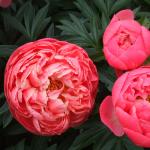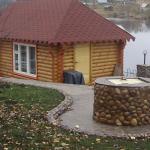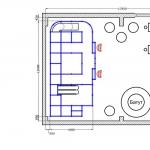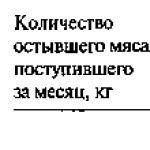Peony Coral Sunset. Peony "Coral Sunset": variety description, cultivation and care
A beautifully flowering and very popular plant that can be found in the front garden of an experienced gardener is the Coral Sunset peony, which harmoniously combines the characteristics of tree-like and herbaceous representatives of the genus. To obtain spectacular bushes with large buds, a beginner should first become familiar with the peculiarities of cultivating a rather finicky flower.
Peony milky-flowering "Coral Sunset" is an interspecific hybrid, which is represented by powerful bushes consisting of erect, well-leafed stems. On average, the height of the shoots, the tops of which are crowned with coral flowers, varies within 1 meter. A characteristic feature of the variety is the lighter color of the central part of the semi-double inflorescences, which are observed as early as June. Flowering duration is 1-1.5 months.
Agricultural technology for growing peony “Coral Sunset”
In order for ornamental bushes to become a decoration of a personal plot, it is necessary to carry out agricultural techniques for cultivating the crop, which includes activities related to planting and caring for the peony.
Peony planting
The optimal time for planting seedlings, which is carried out in sunny, wind-protected areas with fertile and loose soil, is considered to be the end of summer, the first half of autumn, when a drop in temperature to 12°C promotes the development of the root system.

Planting the Coral Sunset peony is carried out according to the following scheme:
- Planting holes are dug with a depth of 80 cm and a distance between them of about 1 m.
- A layer of gravel is placed at the bottom to ensure good drainage.
- Then a mixture of sand, peat and organic fertilizers is added. The composition is mixed.
- A seedling with straightened roots is lowered into the prepared hole and buried in such a way that the root collar is buried a maximum of 3 cm.
- A loose mound is formed around the neck, allowing free access of air.
- The soil in the tree trunk circle is trampled down so that there are no air gaps left near the roots, and watered.
Caring for flowers in the open ground

A spectacular handsome man needs to be systematically looked after, performing a number of mandatory activities.
- Watering - the moisture-loving peony needs additional moisture especially acutely during periods of summer drought, when 10-15 liters of water need to be poured weekly under each bush. Moisture reserves are no less important in the spring during budding and in the fall, when flower buds are formed. For these periods, the required volume is 30 liters of water per specimen.
- Loosening and weeding - in the spring, the soil around the root collar is regularly loosened while weeds are removed. Also It is imperative to loosen the tree trunk circle after the next moistening.
- Feeding and fertilizers – the soil around the perimeter of the tree trunk should be enriched after the peony reaches three years of age. Fertilizing is carried out using complex mineral fertilizers three times per season - in early spring, during the formation of buds, after flowering. The consumption rate per bush is 1 tbsp. a spoonful of azofoska in a bucket of water.
Reproduction

Interspecific hybrids, which include the Coral Sunset peony, are propagated by dividing the bush, also known as root cuttings:
- Three- or four-year-old bushes with a well-developed root system are selected.
- At the end of summer and beginning of autumn, the bush is dug up and removed from the ground.
- The rhizome is placed in a shady place so that the soil dries out and separates easily.
- The bush is divided into parts, each of which should have 3-4 growth buds and a good root system.
- The cut areas are treated with crushed charcoal or activated carbon.
- Delenki are disinfected by placing them in a solution of potassium permanganate for 15 minutes.
- Root cuttings (divisions) are planted in prepared holes, buried and watered abundantly.
- Young specimens are mulched for the winter.
- With the arrival of spring, the mulch layer is removed.
Preparatory activities for winter

When flowering has completed, phosphorus-potassium fertilizers must be applied to the bushes to promote the formation of flower buds, which are the key to future lush flowering. After the first frost, young plants are mulched. Despite the excellent winter hardiness of the variety, it would be a good idea to cover mature bushes that are grown in regions with little snow and harsh winters with a layer of mulch.
Prevention of diseases and pests

Among the diseases, the foci of which can be observed on peonies, are:
- Gray rot is a fungal disease that develops due to excess moisture in the soil. To prevent peonies from being affected by disease, moderate watering of lush bushes should be carried out. If symptoms of rot are detected, it is necessary to immediately remove the damaged parts of the shoots and treat the specimens with a fungicide solution.
- Powdery mildew is another fungal disease, the impetus for its development is excessive air humidity, characteristic of rainy spring and summer. If it is not possible to avoid the disease, then similar fungicides are used as for combating gray mold.
- Curl is a viral disease in which the leaves become wrinkled and the plant stops developing, remaining dwarf. The disease is practically untreatable, so it is more advisable to remove diseased specimens to prevent the spread of the virus.

The most dangerous crop pests are:
- Nematodes are worms that attack both the root system of the peony and the above-ground part. It is recommended to destroy bushes infested with nematodes and water the soil with a solution of potassium permanganate.
- Aphids are microscopic insects that feed on the sap of peony shoots. They pose the greatest danger as carriers of viral diseases. The best preventative measure is to follow the agricultural practices for cultivating the Coral Sunset peony.
- Spider mites are sucking pests that, like aphids, are destroyed by spraying the bushes with an insecticidal preparation.
Peony "Coral Sunset" in landscape design



Herbaceous peony "Coral Sunset", which has a rich salmon color, which at the beginning of flowering has a light peach tint, is often used by landscape designers:
- In single plantings, lush bushes with large inflorescences stand out in contrast against the background of bright lawns with lush greenery.
- In garden flower and shrub compositions, coral beauties coexist perfectly with honeysuckle bushes and blue sage.
- In rock gardens, peony goes well with juniper thickets.
- In border compositions, bushes effectively highlight winding garden paths, harmoniously combining with bearded irises.
Thus, if a gardener wants to decorate the garden with coral colors, then the “Coral Sunset” peony, characterized by early, long-lasting flowering and large inflorescences, is an excellent solution for decorating a personal plot.
In the modern garden, as in the fashion industry, some plants fade into the shadows, while others gain popularity and take center stage in the garden landscape. Such popular new products include ITO peonies. These are hybrids of the herbaceous milky-flowering Kakoden and the tree-like Kinko with yellow flowers. One of the many varieties of ITO hybrids that have won the love of gardeners is Coral Sunset. It is from the famous series of coral peonies by breeder Samuel Wissing, which he registered in the mid-60s of the 20th century. Coral Charm, Coral Sunset and peony Coral Supreme are the most popular herbaceous interspecific hybrids.
Botanical description
The Coral Sunset peony is a perennial herbaceous plant of the Paeoniaceae family. It is an interspecific hybrid, therefore it exhibits characteristics of both herbaceous and tree-like peonies.
From tree-like species, the variety inherited a semi-double flower, its double color, leaf shape, lignified root and renewal buds formed underground.
From herbaceous species, Coral Sunset inherited the annually dying top part and flowering on the tops of one-year-old shoots that grow in the spring.
Peony coral sunset
The bushes spread their densely leafy branches widely. They stand upright and do not fall to the ground under the weight of huge flowers. They grow up to 1 meter in height. They bloom in mid-June.
The leaves are narrow, long, openwork, bright green.
The roots are superficial, grow laterally, and become woody over time.
Semi-double flowers bloom on one-year-old shoots. The color is bright salmon, lighter in the middle and richer at the edges of the petals. The petals are arranged in 5-7 rows. Inside the bud are bright yellow pistils and anthers that attract insects. The size of the first opened buds can reach 20 cm; subsequent lateral buds will be much smaller.
Flowering occurs gradually, several buds open simultaneously. Due to their large number, the flowering period of coral peonies lasts much longer than that of ordinary varieties. Ito hybrids, unlike ordinary varieties, have virtually no odor.
Peony Coral Sunset is classified as a mid-late flowering variety. A plant can live in one place for 40-50 years.
During flowering, the color of the petals changes. They reach their greatest beauty and brightness at the moment of full expansion, and after a few days they begin to fade and become milky yellow.
Interesting. In the first years of life, flowers may be of a simple shape, not double. With age, the bush gains strength, and after 3-4 years the flowers can be semi-double or fully double.
Agricultural technology
All the main species of peonies grow in the mountains; they are accustomed to cold weather and rocky soil. Peonies are best suited for growing in central Russia and southern Russia. Even the loams of the Moscow region are suitable for them, as long as the roots are not constantly in water.
Peony Sunset will grow well in an open sunny location. You should not plant the bush next to trees and buildings, where moisture stagnation or excessive amounts of moisture may occur during precipitation.
Coral peonies do not like acidic soil. Before planting, it must be deoxidized with dolomite flour or lime.
The soil composition can be any (loam, sandy, rocky); it is important that good drainage is created during planting. There is no need to create a special soil mixture for Coral Sunset. If you want to improve the soil on your site, you can mix garden soil, peat and compost in equal parts. Fill the planting hole for the peony bush with this mixture.
Peony coral sunset in a bouquet
The size of the planting hole depends on the size of the plant's root. When planting, flower buds should be close to the surface of the earth. This way they can receive the heat they need to grow. If the root is large, you can lay it on its side or install it in a hole at an angle. Over time, Ito hybrids are able to arrange the roots themselves in a way that suits them. Also, coral peonies of the Coral Sunset variety are able to independently deepen the growth buds to the required depth.
The best time to plant the herbaceous peony Coral Sunset is early autumn. Planting in the fall will give the plant time to grow small suction roots, and it will be better supplied with moisture in the spring.
Spring planting of seedlings involves little risk and additional care for the young plant. A plant that has not had time to take root requires more watering and shelter from the scorching rays of the sun in hot weather. Before planting, the seedling does not need to be soaked in special solutions that stimulate growth. Peonies will begin to be active only when their roots are in the ground.
Care
Caring for Coral Sunset peonies is easy. After successful planting and adaptation to a new location, this plant will require only regular and moderate watering.
On hot days, it is necessary to increase the amount of water, and in rainy summers, additional measures should be taken to save the roots from excessive moisture and rotting. To do this, tablets of the drug Glyokladin are buried five centimeters from the bush. Alirin or Gamair preparations are dissolved in water. The bush is sprayed with this solution (1 liter of water and 1 tablet of the drug), which helps save the rhizomes from rot.
Coral peonies receive all the necessary nutrients from rainwater. If watering is carried out with tap water, then you can add fertilizer in the form of an aqueous solution of ash (1 glass per 1 bucket of water) or mix dolomite flour with soil near the bush.
During the growing season, you can feed the plant with nitrogen-containing fertilizers, and then add mineral complexes containing fluorine.
To quickly build up the root mass, the first buds can be removed from the bush. But, if the plant was not purchased for propagation, then this is not necessary.
Interesting. Ito peonies are “smart” plants; if they don’t need buds, they dry them themselves. When the plant has flowered, it is necessary to remove all the inflorescences so that the plant does not waste energy on producing seeds, but spends it on building up the root mass.
The bush can be transplanted at any time if the place is not suitable for it. To do this, you don’t have to wait for autumn or spring; the plant will suffer more if it remains in a place where it feels bad. After transplanting at inopportune times, additional care for the peony will be required. It must be protected from the sun and watered regularly.
Reproduction
The seed method is used very rarely by amateur gardeners because:
- Peonies produce very few seeds.
- Seed germination is very low.
- Parental traits may not appear in plants grown from seed.
- A full-fledged bush will appear 5-6 years after sowing the seeds.
The easiest and most affordable way to increase planting material is to divide the bush.
It is best to divide the bush at the age of 4-5 years. At a later age, the root becomes very hard and it is very difficult to divide it without significant losses.
The main problem with dividing an adult Ito hybrid bush is in the form of root growth. Herbaceous milky-flowering varieties produce many root interlacings. They are easy to separate or cut with a growth bud for further propagation without much damage to the main bush. In Ito-peonies, all the branches converge at one point, then there is a small isthmus, and from this a root is formed. To separate part of the bush, you need to cut this isthmus. This can be done conveniently with a sharp knife with a thin blade. The cut areas must be treated with disinfectants and dried. After this, the divisions can be planted in a new place.
Interesting. Ito hybrids sometimes remember that they belong to tree peonies and begin to lay above-ground buds. You can do nothing with these kidneys. They are not suitable for reproduction because they cannot be preserved. The bulk of the buds of Ito-peonies are laid underground.
Preparing for winter
Peony Coral Sunset is decorative until frost. Its foliage turns brown with purple hues. After the first frost, the entire above-ground part of the bush is cut off.
During winters with little snow, the bushes are covered with mulch (half a bucket per bush). If winter is generous with snow, then shelter is not required.
On a note. Before covering, each bush can be shed with a solution of phytosporin to prevent fungal diseases.
Diseases and pests
Peonies are very strong and hardy plants, but if the bush begins to wither, the flowers become smaller, and the foliage is not so dense, then you need to dig it up to understand the reason for this behavior.
This may be the formation of rot in the roots of the plant due to excess moisture. Then it is necessary to remove the affected areas and, having made good drainage, transplant the bush to a new location.
The cause of the disease may be age and fatigue of the plant. In this case, the bush must be divided for rejuvenation to occur.
Ito hybrids are resistant to fungal diseases such as rust and botrytis, which often affect the leaves of ordinary herbaceous peonies. But the fungal environment is constantly growing and improving. Perhaps in a few years fungal spores will hatch that will also infect hybrid varieties.
Root nematode
Root-knot nematodes and ants most often attack peonies. The root-knot nematode settles in the roots of the plant. It is very difficult to get rid of it. A plant affected by a nematode begins to wither, lag in growth, and then bloom. It must be destroyed and the planting site treated with formaldehyde. This will not bring a hundred percent result, but it will help stop the spread of the pest throughout the area.
Ants love to feast on the juice secreted from the buds of the plant. To drive them away, the buds can be washed in a warm solution of soapy water, and to get rid of them forever, you need to treat the bush with a solution of Fufanol.
If ants have settled under a peony, this is a signal that the plant is not healthy and measures must be taken to treat it. Ants never settle near healthy plants.
Coral Sunset in the landscape
Coral Sunset in the landscape
In addition, unlike herbaceous species, Coral Sunset has a long growing season. Even after flowering, its foliage fills the garden with bright greenery all summer, and with the onset of cold weather the leaves turn purple and the garden lights up with flames.
At the first frost, the branches and leaves are covered with silver frost, which looks very beautiful against the backdrop of dying nature. This gives the peony bush a new, albeit short-lived, life as a new art object.
In group plantings, peonies occupy a central place. In such a planting scheme, you need to give Coral Sunset a place that will have a good view from different parts of the garden.
Coral Sunset peonies are loved by florists because they look good both in group compositions and in solo bouquets.
Among peonies, the coral series has recently been of particular interest to gardeners. It consists of interspecific hybrids with unusually attractive colors of inflorescences. This group also includes the Coral Sunset variety, which has gained popularity among our compatriots. Let's find out more about him.
History of appearance
Coral sunset embodies a successful combination of tree and herbaceous varieties. Two breeders did a lot for its appearance: the American Samuel Wissing and the Canadian Lyman Cousins. But much of the credit for this work still belongs to the first scientist, since he is the direct author of Coral Sunset. He spent 26 years creating a noble culture. The world learned about the peony variety, whose name in English translates as “coral sunset,” in 1965, and the popularity of the flower has not decreased to this day - both among professionals and among novice flower growers. Over the years, this crop has participated in various competitions, where it received high awards and titles not only for its magnificent appearance, but also for its unpretentiousness and resistance to cold.
Description of the variety
Coral Sunset is a powerful, compact, perennial bush up to 110 cm high. It has strong, strong stems that rise above the green mass by approximately 15 cm. Peony leaves have a rich green tint. The diameter of the crown of the bush is 0.8−0.9 meters. At the top of each shoot, one large flower is formed, the width of which varies from 15 to 20 cm. The petals in the blossoming bud are arranged in 5-7 rows. The flowers of Coral sunset are semi-double, rich coral shade. In the middle the inflorescence is lighter, while the tips of the petals are somewhat darker. At the beginning of flowering, the buds are colored pink and peach. It is noteworthy that the flower petals are mostly curved towards the center, but do not cover the core. The cup-shaped flowers are very fragrant. Their fragrance can be described as delicate and refined.

Peony blooms in the first ten days of June. This period lasts for 1−1.5 months. But know that the shrub does not bloom profusely immediately, but only in the third year of life, and even then with strict adherence to the rules of care. Coral Sunset is a winter-hardy variety. Its roots do not die even in Siberian frosts, however, if there is sufficient snow cover. If you adhere to the recommended principles of growing a crop, you can significantly reduce the risk of diseases developing on it and attacks by insect pests.
Agrotechnical features
To place the bush, you should choose a well-lit area, protected from gusty winds. It is better not to plant it in the shade, otherwise you will not get abundant peony flowering. If you decide to grow a crop next to a garden fence, do not forget to maintain a distance between the bush and the building for the full development of the plant.
Coral Sunset loves fertile, loose soil. The best option is to plant the flower in light loamy soil. When planting a crop in ordinary garden soil, it must first be fertilized with humus (2 parts), and also sand (1 part) and turf soil (2 parts) added to the substrate. This mixture is poured into a hole about 50 cm deep. The plant is planted at the end of summer or the first half of autumn. This allows the culture to better take root in a new place. When planted in spring, Coral sunset will suffer more from the summer heat.

The peony needs to be watered with enviable regularity: young specimens more often, adults less often. Moistening the soil under the flower should always be plentiful and done with soft water at room temperature in the amount of 1-2 buckets per bush. Avoid drying out the soil. After watering, the area around the tree trunk must be carefully loosened. Mulching the soil is necessary only in the fall, before the onset of the dormant period. Mulch is straw or dried grass. With the onset of spring, it is removed from under the bush.
In the first year of Coral's life, Sunset is not allowed to bloom. Only the tiny buds that have formed should be plucked out. This measure contributes to the formation of a powerful root system. In the middle or end of spring, in order to accelerate the growth of adventitious roots, the peony is watered with water with a root stimulant dissolved in it.
In the process of caring for young and adult bushes, systematic weeding is important. From the third year of life, the soil under the plant begins to be fertilized. Mineral complexes containing phosphorus and potassium are suitable for feeding. They are applied under the bush during budding and three weeks after flowering. Frequency of this event: 1-2 times a month.
When the first autumn frosts make themselves known, the fallen shoots with leaves are carefully cut off, leaving only a short stump. The onset of stable cold weather is a signal to mulch the area around the plant with compost or sawdust. It is not necessary to cover Coral sunset for the winter.
Powdery mildew, gray rot and curl are likely to appear on the bush. Treating the plant with a solution of any fungicide can handle them. Of the insects, Coral Sunset loves nematodes, which can damage any part of the peony. The variety will get rid of them with an insecticide. It is advisable to carry out preventive spraying 2-3 times per season.
Use Cases
A noble plant will favorably emphasize the beauty of a flower bed or garden plot if you place it in group compositions with other peonies or other flowering perennials that have the same shoot height as our hero. The variety is appropriate in mixborders, in ensembles with decorative foliage crops. It can also be planted as a single bush. Sunset coral goes well with low-growing conifers and evergreens, as well as roses and clematis. Shoots with coral flowers make delightful bouquets.
×
My Family Garden - Help
Dear friends!
It’s very easy to get lost in such a large assortment of all kinds of products, and of course you want so many things! But it happens that it is not possible to order everything at once.
So that you don’t lose the products you like and don’t waste time searching for them, we have created a convenient section for you where you can save the items you like.
Now you can create your own “Family Garden”.
On the page of our new section you have the opportunity to create convenient lists for you where your plans for future plantings will be stored.
Sort products into lists by price, culture, planting time, or any property convenient for you.
Did you like something but want to order it later?
Create a list, save the selected items there and, when the time comes, click the “all items to cart” button. The total amount of the future order will be shown in the lower right corner.
To get started, use the already created “Favorites” list and save all the items you like to it. If you want to create a list with your own name, just click the “Add new list” button. Give it any name that will help you navigate, for example, “Seeds for 2016”, “My Club”, “Summer Flowerbed”, etc. And when the time comes, in a few clicks order all the necessary goods, for example, for your winter garden.
Now viewing the detailed description of the product, you can click the “Add to My Family Garden” button, and the product you like will be saved in the folder of your choice.
Easy, fast, convenient! Happy shopping!
How to use the My Family Garden section
To add a product to My Family Garden, you must go to the product page.
In the additional window that appears, you must select the list to which you would like to add the current product. You can select New List by giving it a name. After selecting the list, you must click on the “Ok” link.

My Family Garden
On the section page you can view all the products you have added, as well as the lists you have created.

From here you can add items to your cart individually:

And also the whole list:

You can also remove a product from the selected list:

Or clear the entire list of products:

To completely delete the list, use the following link:

Create lists on various topics. Examples of names can be very different: “My future summer flowerbed”, “For the dacha”, “Apple orchard” and many others. Do you know exactly what fruit and berry seedlings you will order? So call the list “Delicious”, adding your favorite varieties there. And when the time comes, order the entire list in just a few steps.
We have done everything to make My Family Garden as convenient and easy to use as possible!
When you imagine a romantic evening, what do you see? Most often, a picture of a colorful sunset, azure sea and white sandy beach comes to mind. Blooming flowers will become an island of paradise in your cozy garden. peonies Coral Sunset (Coral Sunset). Description and photo of peony Coral Sunset already available in the catalogue.
Nature plays with soft sunny colors, painting this amazing flower. Peony herbaceous Coral Sunset combines pink and creamy tones, which, over time, fade under the scorching sun to soft peach and salmon tones. A lush bush 90 cm in height grows in an incredible picture, mixing buds of different colors. A distinctive feature of this peony is its brightest, rich aroma, which distinguishes it from other Coral peonies.
Semi-double bud Peony Coral Sunset consists of 5-7 rows of magnificent petals and reaches a diameter of 16-20 cm. The staminodes are large, bright yellow, and form the center of the composition. Peonies Coral Sunset They will be a wonderful decoration for any flower arrangement, and the early flowering period will allow you to enjoy the beauty of this flower from the beginning of May.
Peonies planted in well-fertilized soil do not need to be fertilized in the first year and several subsequent years. After transplantation, varietal qualities appear in 2-3 years!
In autumn, with the onset of stable frosts, around mid-October, the stems of peonies are cut off, leaving stumps 1-2 cm high above the buds. For the winter, peonies are covered with a layer of peat or unripe compost. There is no need to cover adult plants.
To send peony Coral Sunset a standard cut with 2-3 buds is used in the amount of 1 piece. Delivery is carried out by Russian Post, transport companies PEK, SDEK or others as agreed with you.
Order and buy peony seedlings Coral Sunset (Coral Sunset) You can click the "Add to Cart" button and place your order.
Type of packaging: a bag of peat, a label indicating the variety, a standard section with 2-3 buds.
Delivery terms: Orders with peony seedlings are sent in the autumn, from September 1, and spring, from March 1, seasons (shipping restrictions in accordance with the customer’s climate zone).





